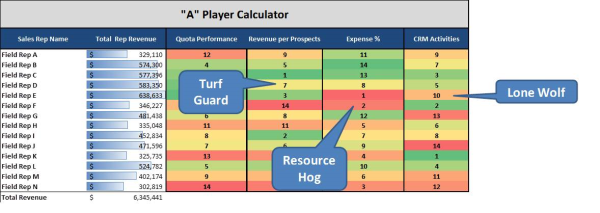3 "A" Players Who Aren’t Really “A” Players
3 "A" Players Who Aren’t Really “A” Players:from Sales Force Effectiveness Blog
A good VP of Sales knows their top performers. But when we ask, "How do you determine performance, besides quota attainment?" details become elusive. Quota attainment is a good starting point for talent assessment. However, it’s not the bellwether many believe. In fact, many reps who achieve quota aren’t all-stars. Listed below are three examples of pseudo top-performers, and how to determine if your “A” Player is one. Download our “A” Player Calculator and build a talent scorecard on more than just quota.
 The Turf Bully
The Turf Bully
The Turf Bully is usually a grizzled veteran recognized as a consistent performer. He doesn’t blow out the number, but always delivers more revenue than the average rep. He’s cited for his extensive network and performance consistency. He gets protective of “gray area prospects” who stretch across several regions.Problem: The Turf Bully is successful because he’s claimed the biggest patch of land. Every time there’s a territory rezoning he bellyaches. You can’t turn them over to someone else, I brought them in! Or If you chop up my territory, I’ll look somewhere else. He mostly gets his way. Because of this, prospects and existing customers don’t get the same level of service. He is spread too thin.
How to Spot Them: Look at the number of prospects in each territory. No territory should have twice the amount of any other. If reps are responsible for prospecting, use a proxy like population. Also, examine undivided states like “New York” or “California” where the Turf Bully lurks.
The Resource Pig
The Resource Pig always hits their number, no matter the cost—to the company. In technical product sales they have a Sales Engineer on a leash. Also, they are known for hosting extravagent “wine and dine” events to close prospects. While they are cognizant of revenue, they are ignorant of costs.Problem: Although the resource pig hits their number, their deal profitability is awful. Sales Engineers feel constrained and overworked. Big client expenditures create resentment among the rest of the sales team. Other reps take note, and your sales expenses balloon.
How to Spot Them: Start tracking costs of the sale—in terms of expenses, resources allocated (in dollars), and overall deal profitability. Their expenses to revenue ratio will usually be twice as high as the typical “A” Player.
The Lone Wolf
This is one of the most common “A” Players who persist in an organization. She is the one who consistently outperforms on her own terms. CRM adoption? Nope. New Sales Process or Methodology? No buy-in. She doesn’t care about corporate initiatives or training. Just stay out of her way and let her sell.Problem: As a widely recognized contributor, young reps look to top performers. Here they see a rep who flagrantly ignores the rules and gets away with it. They think, if she doesn’t have to do it, I don’t either.
How to Spot Them: Corporate initiatives and non-selling job requirements get minimal attention. System usage is weak, and rules are ignored. Unlike the other two Pseudo “A” Players, managers usually know who these reps are. The problem is reining them in.
 What do you when you find one of these Reps masquerading as an “A” Player?
What do you when you find one of these Reps masquerading as an “A” Player?1) Talk to them about what you’ve found: Don’t just corner him and make accusations. Have a sit-down discussion about your department's priorities. Show him the data from the "A" Player Calculator. Tell him why this is impacting your goals (aka the Problem). This should not be an emotional conversation. It should appeal to their logic.
2) Tell them what they can expect: If it’s a Turf Bully, let them know the territory will be reduced. If it’s a Resource Pig, let them know you’re tracking costs as part of performance. If it’s a My Way Detractor, let them know quota attainment is only part of their position. You expect more.
3) Make the changes: Implement the change. No matter what the circumstance, exalting a mediocre performer undermines your efforts. Message the entire organization on why the change was made without placing fault on anyone.
4) Continue to measure: Don’t just assume the problem is solved. Continue to track metrics and make sure they’ve changed behavior. If they haven’t, it might be time to let them go.
Your job as Sales VP is to produce a highly functioning sales force. It's not to protect or reward those that undermine your objectives. Download Our “A” Player Calculator today and find out who your true star performers are.
Author: Drew Zarges
Follow @DrewZarges
Follow @MakingTheNumber
If you enjoyed this post, never miss one again by subscribing your Email Here and/or subscribing to the RSS Here.



No comments:
Post a Comment